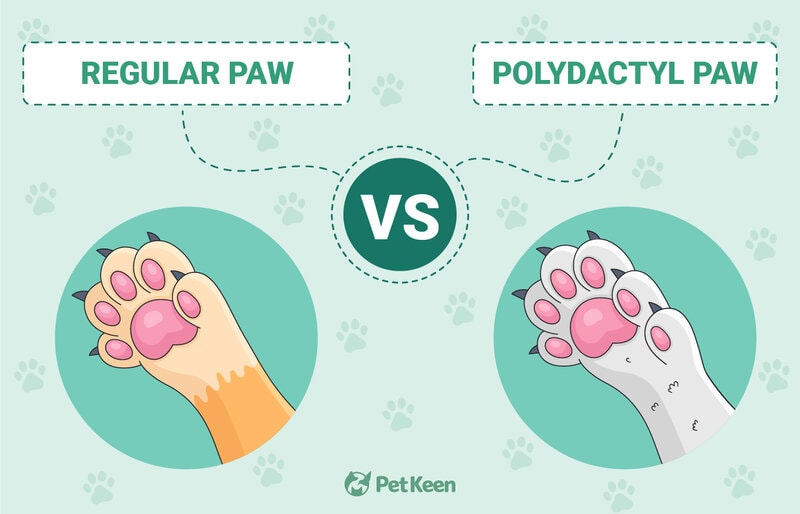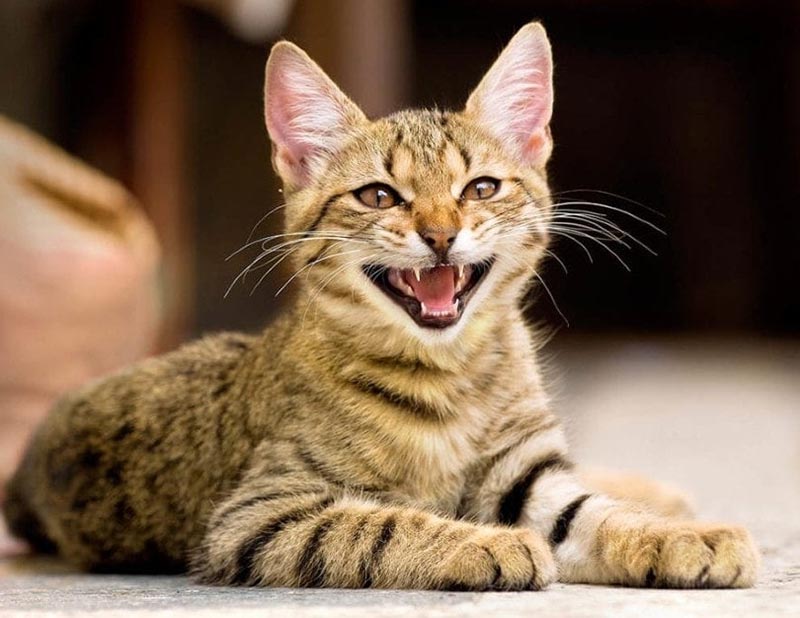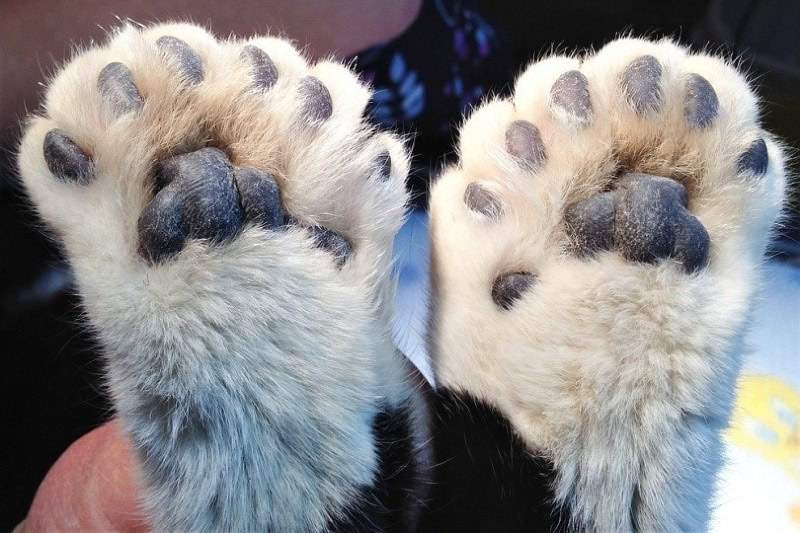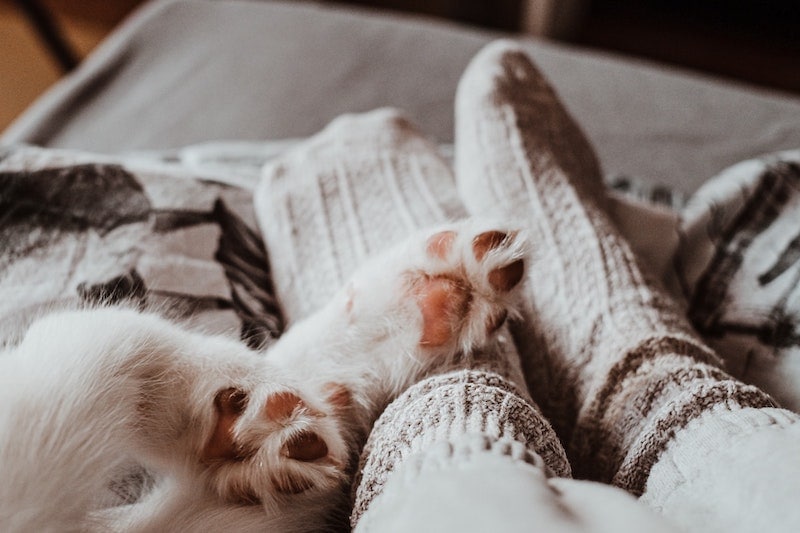VET APPROVED

The information is current and up-to-date in accordance with the latest veterinarian research.
Learn more »Click to Skip Ahead
If you watch online cat videos, you may have noticed that some pet owners like to focus on their cats’ paws. Cats’ toes are adorable; the fluffy feet and soft “toe beans” make everyone feel good, but sometimes, you’ll see a cat’s foot that looks decidedly different from any other.
These cats have more toes than the standard 18 that most cats have, and some cats can have as many as 22 toes or more! Cats typically have 18 toes: four on the back paws and five on the front. However, cats with a genetic condition called polydactyly can have extra toes on one, two, three, or all four paws..

Can Cats Have Extra Toes? What Is It Called?
Cats can have extra toes, and some cat breeds are more prone to this congenital anomaly. Main Coon and Pixie-Bob cats are among the cat breeds that are most commonly born with polydactyly. The origin of the word is Greek: poly means many or multiple, and dactyl means digits or toes. This condition is not painful, and it’s not known to be associated with any health problems.

What Causes Extra Toes on Cats?
Polydactyly (or hexadactyly/hyperdactyly) is inherited from one or both of the parent cats, from parent to kitten. It is an autosomal dominant genetic trait with high penetrance, meaning it is highly likely to be expressed when the gene is present. A total of three mutations causing polydactyly in cats have been identified so far. These are the Hw mutation in Maine coon and Pixie-Bob cats, and the UK1 and UK2 mutations in British domestic short hair cats. A study in 2020 revealed that the three genetic variants responsible for polydactyly could be found in specific locations worldwide, in the U.K., Europe, and the U.S.
Are Extra Toes Common in Cats?
Polydactyl cats are relatively common within certain breeds. At one point, approximately 40% of Maine Coons were born with extra toes. Nowadays, it’s much less common since breeders have started to breed out this trait. Interestingly, however, the geographical location of the cat makes a difference, as cats born in some regions of the U.S. are more likely to be polydactyl than the general cat population.
Cats born in Wales, along the West Coast of England, and the Coast of Maine in the United States are more likely to be polydactyly. The most common theory for the specific areas in which polydactyl cats are more common is because of how popular they were as ship cats, reaching different ports around the UK and US and breeding with local cat populations.

Which Breeds Have Extra Toes?
Until recently, no specific breeds had extra toes as part of their breed standard or type. However, there are two breeds now bred specifically to include extra toes, with the usual amount of toes being undesirable.
Maine Coon cats have historically had extra toes on their feet, and these cats are identified by The International Cat Association (TICA) as Maine Coon Polydactyls. According to TICA, it is believed that this helped them use their paws as “natural snowshoes” during snowy Maine winters.
Pixie-Bob cats are the other breed that is accepted with extra toes. This could be due to the breed’s ancestors having extra toes and the gene being expressed in each litter when the breed was first created.
Where Are the Extra Toes on Cats?
Polydactyl cats can grow toes on the left, right, or center of their feet. Cats with extra toes on the outside side of their feet are known as postaxial polydactyly, cats with more toes on the inner side are known as preaxial, and the rarest of all forms of polydactyly is medial, where toes are grown in the middle of the limb.

Do Extra Toes Hurt Cats? Are They Dangerous?
The extra toes a cat can grow can either be fully functional or have extra skin and muscle. Usually, the toes are functional and can help cats by providing more traction and grip when running or climbing trees. The extra toes don’t harm the cat in most cases, but you should monitor them to make sure the extra toes don’t present a problem.
If the toe is more akin to soft tissue growth, it can be partially or completely detached from the rest of the paw structure. These loose toes can increase the risk of accidental injury, as they often still have claws that can get caught. However, in most cases, the extra digits have the same bones, joints, and everything they need to function as normal toes.
If the toe or toes grow at an angle, watch for any signs of claw growth or overgrowth. They possibly won’t be filed down as quickly as the other toes and might begin to dig into the paw pads or other toes; keeping them clipped regularly can avoid any possible injury to the claw or other toes on the paw.
Why Are Cats With Extra Toes Called “Hemingway” Cats?
The famous author Ernest Hemingway was gifted one of his most prized possessions in the 1930s: a white polydactyl cat named Snow White. The kitten had six toes, and Hemingway received her as a gift from a ship’s captain. Snow White gave birth to several polydactyl kittens, and many of the cats roaming the Hemingway Museum and island are polydactyl and thought to be Snow White’s descendants.
These cats have given the polydactyl cats the nickname “Hemingway” cats, along with sometimes being called “mitten cats” or “snowshoe cats” because of their larger, wider feet.

Final Thoughts
Polydactyl cats have more than the standard 18 toes and can have up to 28, but even cats with one extra digit on one foot are polydactyl. These toes can be either fully functioning or more similar to fleshy growths, but they’re usually not a hindrance or dangerous to the cats that sport them.
Instead, they’re a cute genetic quirk passed down from parents to their offspring. If you have a cat with extra toes, keep an eye on them for any signs of claw trouble in case they grow at angles. But, for the most part, you’ll be able to enjoy watching your polydactyl cat’s extra-special paws at work!
- https://journals.sagepub.com/doi/10.1177/1098612X20905061
- https://etobicokehumanesociety.com/education/polydactyl-cats-toes/
- https://www.frontiersin.org/articles/10.3389/fgene.2018.00447/full
- https://www.hemingwayhome.com/our-cats
- https://www.hemingwayhome.com/our-cats#:~:text=Ernest%20Hemingway%20was%20given%20a,are%20not%20a%20particular%20breed.
- https://link.springer.com/article/10.1007/s11692-013-9267-y
- https://www.treehugger.com/thing-didnt-know-polydactyl-cats-4864197
- https://www.wideopenpets.com/story-ernest-hemingway-six-toed-cats/
- https://www.purina.co.uk/articles/cats/behaviour/common-questions/polydactyl-cats
Featured Image Credit: Valeriia Miller, Unsplash











